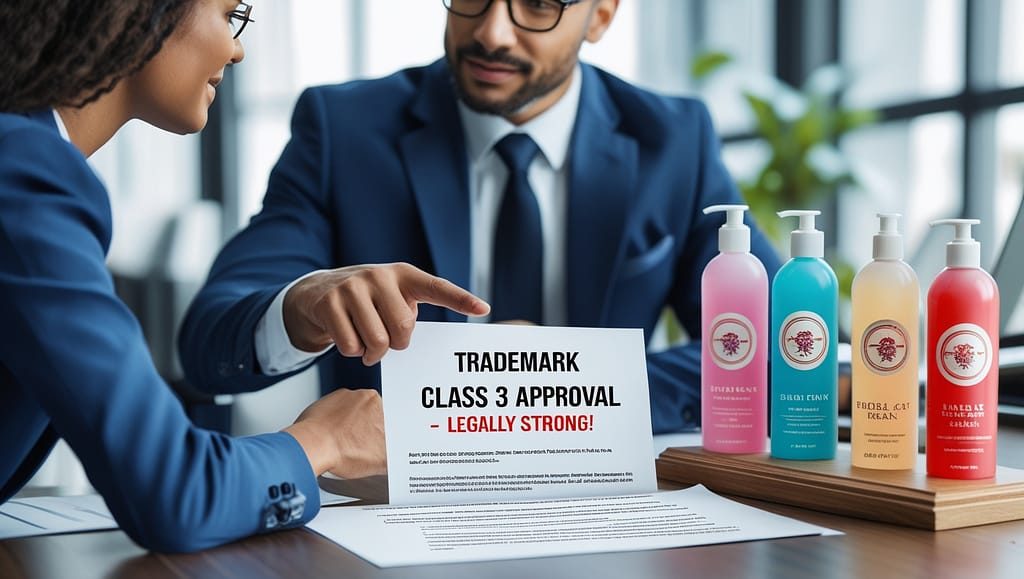The beauty and cleaning industry is highly competitive, with new brands entering the market every day. Whether you sell skincare products, perfumes, soaps, or household cleaning supplies, protecting your brand identity is essential. Without legal protection, another company might use a similar name, causing confusion among customers and potential legal disputes.
Trademark registration helps secure exclusive rights to your brand name, logo, and packaging. If your business falls under Trademark Class 3, which covers cosmetics, toiletries, and cleaning products, registering your trademark ensures that no one else can misuse or copy your brand. In this guide, we’ll explain how to make your Class 3 trademark legally strong, the registration process, and common mistakes to avoid.

Understanding Trademark Class 3
A trademark is a legal tool that protects a brand’s identity and prevents competitors from using similar names or logos. The trademark classification system consists of 45 classes, each covering different types of goods and services.
Class 3 specifically includes:
- Cosmetic and Beauty Products – Skincare creams, lotions, makeup, perfumes, deodorants
- Haircare and Personal Hygiene – Shampoos, conditioners, soaps, shaving creams
- Household Cleaning Products – Detergents, cleaning sprays, disinfectants, polishes
If your business operates in this category, trademarking under Class 3 helps protect your brand and prevents others from using a similar name for related products.
Why Trademark Registration Matters
Brand protection is crucial in industries where counterfeiting and imitation are common. A trademark ensures that your brand is legally recognized and gives you exclusive rights over its use.
Here’s why trademarking your beauty or cleaning brand is important:
- Legal Ownership – A registered trademark grants you full rights over your brand.
- Market Recognition – Customers associate trademarks with quality and trust.
- Protection Against Infringement – Prevents competitors from using a similar name.
- Business Growth – A trademark strengthens your brand’s reputation, allowing for expansion into new markets.
- Higher Business Valuation – Investors and buyers prefer businesses with legally protected trademarks.
Without a registered trademark, your business risks legal conflicts and brand dilution, which can negatively impact growth and customer trust.
Steps to Register a Strong Trademark in Class 3
- Choose a Unique Brand Name Your brand name should be distinctive to ensure easy registration. Avoid common or descriptive names like “Soft Soap” or “Natural Cream,” as they may be rejected.
- Be creative and unique (e.g., “GlowVera” for skincare or “ShinyMop” for cleaning products).
- Avoid using common industry terms.
- Check if the name is available as a website domain if you plan to sell online.
- Conduct a Trademark Search Before applying, check if your desired name is already registered by another company. This helps avoid legal disputes and ensures smooth approval.
- Use the IP India Public Search Tool to verify name availability.
- Consult a trademark expert to conduct a thorough search.
- File a Trademark Application Once you confirm that your brand name is available, submit an application to the Indian Trademark Registry. You will need:
- Your brand name and logo.
- Details about the class of goods (Class 3 for beauty and cleaning products).
- Business ownership details.
- Government filing fees.
You can apply online through the IP India website or hire a trademark consultant for a hassle-free process.
- Examination and Publication in the Trademark Journal The Trademark Office will examine your application to check:
- Whether the name is unique and distinctive.
- If it conflicts with existing trademarks.
- If it meets all legal requirements.
If the application is accepted, it will be published in the Trademark Journal for public review. If no objections are raised within four months, the process moves to the next stage.
- Trademark Registration and Certification If no one opposes your trademark, the Trademark Registry will issue a registration certificate. This officially grants you exclusive rights to your brand under Class 3. The trademark is valid for 10 years and can be renewed indefinitely.
Common Trademark Mistakes to Avoid
Many businesses face delays and rejections due to common mistakes in the registration process. Avoid these pitfalls:
- Using a Generic or Descriptive Name – Difficult to trademark and may be rejected.
- Skipping the Trademark Search – Increases the risk of application rejection.
- Filing Under the Wrong Class – Can lead to incomplete brand protection.
- Ignoring Trademark Objections – If you receive an objection, failing to respond in time can result in rejection.
- Not Renewing Your Trademark – If you don’t renew after 10 years, you may lose ownership rights.
What to Do If Someone Copies Your Trademark?
If you find another company using a similar name or logo, take action to protect your brand:
- Send a legal cease-and-desist letter.
- File an official complaint with the Trademark Office.
- Take legal action for damages if necessary.
A registered trademark gives you legal authority to prevent others from misusing your brand identity.
Get Professional Help for Trademark Registration
Trademark registration involves legal procedures that can be complex for business owners. A professional trademark consultant can help ensure smooth registration, handle objections, and provide legal protection.
At VMK Professionals, we offer:
- Comprehensive trademark searches to check availability.
- Proper application filing to increase approval chances.
- Handling of objections and legal challenges.
- Complete trademark registration services for Class 3 brands.
Protect your beauty or cleaning brand with a legally strong trademark. Contact VMK Professionals today and secure your brand’s future.
